This series is available as a PDF download at the bottom of the page.
The growth in sales and market share of machinery and industrial plant manufacturers is largely due to the fact that products or entire product system solutions can be globally offered in ever more varied forms. This ability becomes a decisive success factor for the future of companies. As digitization progresses, companies will continue to be successful if they come to terms with the disruptive character of this development and open up to meaningful new possibilities and technologies.
Not only will this transformation continue, but it will further pick up the pace as the number of options available to digitize increase. Industry 4.0 offensives including IoT, networking of digitizable products, a considerably higher degree of automation, even faster development cycles or the use of business solutions such as S/4 as a “digital core” are popular in manufacturing companies – the goal is to be able to manufacture a wide variety of products practically at the push of a button or in the shortest possible time. At the same time, it is also essential to expand or transform the distribution and sales of complex and versatile products in the direction of 4.0.
Homo Digitalis and customer journey
The hallmark of current sales activities is extreme global competition, which provides the buyer, as “Homo digitalis”, with a large number of suppliers with customer-specific product ranges. A high degree of identification with the product and successful presentation of the USPs (unique selling propositions and competitive advantages) during the sales process are decisive for a successful bidding process. Virtual Reality can ensure success in this scenario. Speed is equally important, i.e. the time in which an appealing and correct offer, also for complex products and plant systems, can be submitted.
Successful order generation and booking aside, ensuring an error-free configuration with correct pricing is of decisive importance to the manufacturer. Another important factor for a lucrative order is the cost of preparing a quotation, which means that unneeded internal coordination for technical feasibility checks or the redesign of layout plans must be avoided. The sales department itself must be in a position to carry out these necessary checks and adjustments within the framework of predefined rules – firstly, to be able to get the offer out quickly and secondly without additional internal cost.
In addition, changes in customer behavior in the decision-making process are to be expected: interested customers will have to be able to access offers digitally on their own initiative in the future – which means making use of Virtual Reality technologies. From a customer’s perspective, a large part of the bidding process, the so-called customer journey, has already been completed with the request for quotations from the supplier. The customer then expects fast, competent and tailor-made offers. These requirements can only be fulfilled through a symbiotic use of ERP and CAD data within the CPQ process.
Sales and service 4.0
Identifying new customer needs and market developments quickly and reacting to them better than the competition are key competitive factors in the age of digitization. The next level for the bidding process means that even greater external digitization is taking place. With the use of so-called digital twins, product data from the design and ERP environment are transferred to new digital fields of application. Preparing products for Virtual Reality, for example, makes it possible to experience the USPs of a product hands-on. Further value is added, for example, in service, since Virtual Reality instructions can be generated for each customer-specific system. At the same time, digitization is also taking place internally, for example through automated and comprehensive re-import of customer-specific order data into CAD systems and, of course, into ERP solutions.
Bridging the gap
Configure Price Quote software solutions have long supported sales teams effectively in the bidding processes. While the focus always is on complex products, numerous variations and a large number of individual features, CPQ systems significantly simplify and accelerate existing configuration processes. At the core, they contain a product configurator and they can be linked to or extended with CRM systems (Customer Relationship Management). At the same time, for example, they create a connection to an ERP system, ERP/ECC 6.0 or S/4 (LO-VC), to ensure the exchange of relational data. CPQ software is also able to generate production orders (e.g. with material requirements or bills of materials) or can trigger the production of a product (following internal checks or simulations).
Agility and Virtual Reality
SAE has implemented the principles of a process-integrated, virtual and interactive product configurator in the new and already tested next generation CPQ software solution SAE Sales and SAE Interactive Motion Engine (SAE IME). Product variations as well as machine and plant systems can thus be configured in an interactive Virtual Reality. In tandem with SAE Sales, the SAE application for quotation management and the data management tool SAE Developer, an integrated system is created for every company. The most important point: IT or CAD expertise is not a requirement for sales teams when using SAE IME. The application generates interactive digital twins in a separate data format (“IME datafile”), at the push of a button. The sales department thus remains anchored in its core competence, while the innovative SAE solutions provide all the support the sales staff needs. Furthermore, SAE IME is based on SAE’s many years of experience in the field of CPQ software using ERP systems (SAP ERP, SAP S/4 Hana) and on its expertise in the field of 3D configuration.
Digital twin
Functioning through a symbiosis of ERP master data, design data, configuration, pricing and Virtual Reality, the Interactive Motion Engine (IME) is in fact the only solution of its kind worldwide. The aim is to generate a digital core, which is vital to all 4.0 activities. In practice, the digital twin is a virtual image of the configured product that accompanies the entire product life cycle as the digital core of that specific product. This valuable source of data is also used for efficient after-sales management, such as technical service and maintenance.
CAD and 3D Visualizer
The core of the SAE Interactive Motion Engine is a so-called digital twin, which is automatically generated in the SAE application from the CAD design data. The file is cloud-ready and comes in a separate data format (IME-format). Product Management only has to create the variants and functions of the product in a customization process. The high level of customizability of SAE Interactive Motion Engine ensures that the sales process is agile. Regarding performance and protection of intellectual property, it is important to make clear that the digital twin of a complex CAD model in the IME-format only consists of the relevant sales data.
After separate object dependencies and technical rules are added in the application, the 3D model can firstly be operated and configured by laymen and secondly ensures your intellectual property, like sensitive construction data, is protected, since these are only handled internally. It should be expressly pointed out that the SAE Interactive Motion Engine is neither a classic 3D visualizer, nor a generator of complex individual models. Object dependencies from ERP systems are stored in the SAE Interactive Motion Engine.
What’s more, there is complete process integration in CRM, PIM or SAP systems. The SAE data format enables the data for web use – both CAD data and variant master data, for example. Put into practice, that means relevant SAP ERP LO-VC data also has the (necessary) web capability. The advantage: IME can also be used as a cloud solution around the globe. SAE solutions have always been designed for international use (with country- specific pricing). As a result, international sales teams with IME are able to configure and present offers live and in an interactive manner. With the creation of interactive Virtual Reality models and without CAD knowledge, the sales team now can deliver a completely new and motivating sales experience. For the buyer, but also for the seller.
Speedy offers and cost effectiveness
It is important to note that all SAE applications operate in conjunction with ERP and CRM systems. The generated SAE data format enables all design and sales data from the respective systems for web use. In SAE applications, for example, relevant SAP ERP LO-VC data can be made web-enabled and is then usable in a Virtual Reality environment. As an additional advantage, the SAE applications have always been designed for international use, i.e. with specific country pricing and also offer document management for the sales process. They are already in use in over 50 countries.
A new feature for sales teams is the ability to use SAE IME as a CPQ component to carry out characteristics evaluations together with customers directly on the model, namely as fully dynamic, interactive Virtual Reality motion simulations as part of the quotation process – with ERP integration. Control is ensured using predefined degrees of freedom and existing object dependencies. It is also relevant that no specific technical and sensitive CAD data with design details or development know-how is used in the cloud.
Cross your heart: Who would really be willing to make his design data publicly available? Be it via changing sales staff as over-secure data connections. The digital twins only contain necessary information for the sales process. Thanks to SAE IME, sales teams can generate complex product models and variants in VR on site – but without having to burden a (CAD) development department at a company headquarters again and again for quotation purposes.
On top of this, queries often made between sales and development may simply become obsolete. The benefit of the CPQ solution is obvious: bidding processes are accelerated significantly and bidding costs are noticably reduced in a lot of cases.
Short facts on the SAE Interactive Motion Engine
► Real-time interactivity between configuration and 3D movable model.
► Configure complex machinery without CAD know-how.
► Control based on degrees of freedom and based on stored technical rules.
► Characteristics evaluation directly in the model or in the configuration overview.
► Configuration options and model behavior easily and comfortably customizable.
► Fully dynamic motion simulation and interactive layout planning.
► Highest data security: Database without technical CAD data.
► Data transfer to ERP systems e.g. SAP S/4Hana or CRM systems like C4C or Salesforce.
► Complete cloud capability.


















![virtual reality The future will be dominated by virtual and interactive product configuration. [shutterstock: 796031083, Beros919]](https://e3zine.com/wp-content/uploads/2018/05/interactive_VR_CPQ_ERP_shutterstock_796031083web.jpg)

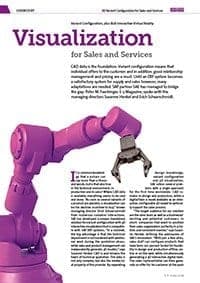
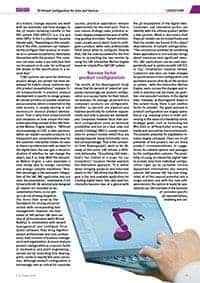
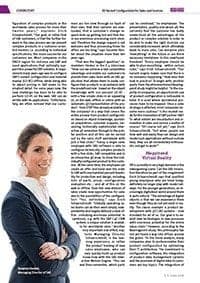
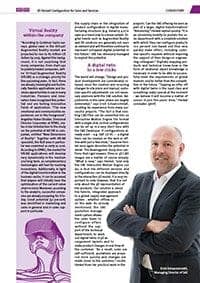
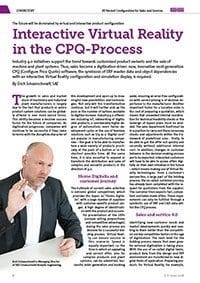
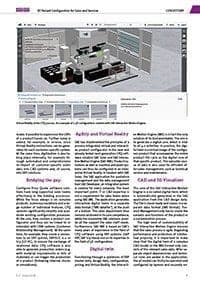
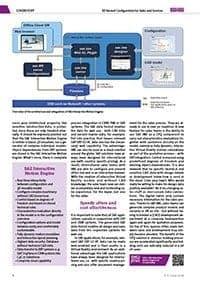
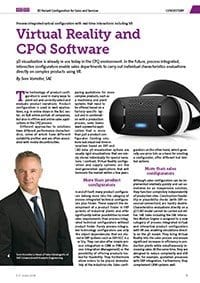
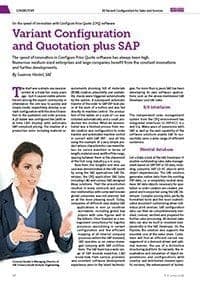
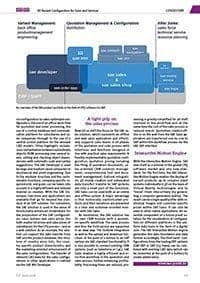



Add Comment